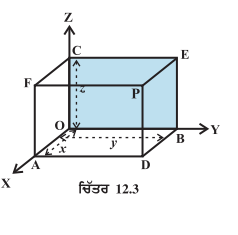ਕਾਟ ਸੂਤਰ ਦੀ ਵਰਤੋਂ ਕਰਦੇ ਹੋਏ, ਦਰਸਾਉ ਕਿ ਤਿੰਨ ਬਿੰਦੂ (-4, 6, 10), (2, 4, 6) ਅਤੇ (14, 0, -2) ਸਮਰੇਖੀ ਹਨ।
Step by step video & image solution for ਕਾਟ ਸੂਤਰ ਦੀ ਵਰਤੋਂ ਕਰਦੇ ਹੋਏ, ਦਰਸਾਉ ਕਿ ਤਿੰਨ ਬਿੰਦੂ (-4, 6, 10), (2, 4, 6) ਅਤੇ (14, 0, -2) ਸਮਰੇਖੀ ਹਨ। by Maths experts to help you in doubts & scoring excellent marks in Class 11 exams.
Updated on:21/07/2023Topper's Solved these Questions
- ਤ੍ਰੈ- ਵਿਮਾਈ ਜਿਆਮਿਤੀ ਦਾ ਅਸਥਾਪਨBOOK - PSEB (PUNJABI MEDIUM)CHAPTER - ਤ੍ਰੈ- ਵਿਮਾਈ ਜਿਆਮਿਤੀ ਦਾ ਅਸਥਾਪਨEXERCISE - EXAMPLE
13 Videos
- ਤਿਕੋਣਮਿਤੀ ਫਲਨBOOK - PSEB (PUNJABI MEDIUM)CHAPTER - ਤਿਕੋਣਮਿਤੀ ਫਲਨEXERCISE - EXAMPLE
29 Videos
- ਦੋ ਪਦੀ ਪਰਿਮੇਯBOOK - PSEB (PUNJABI MEDIUM)CHAPTER - ਦੋ ਪਦੀ ਪਰਿਮੇਯEXERCISE - EXAMPLE
12 Videos
Similar Questions
ਚਿੱਤਰ 12.3 ਵਿੱਚ P ਦੇ ਨਿਰਦੇਸ਼ ਅੰਕ (2,4,5) ਹਨ ਤਾਂ F ਦੇ ਨਿਰਦੇਸ਼ ਅੰਕ ਪਤਾ ਕਰੋ ।

View Solution40∘ 20' ਨੂੰ ਰੇਡੀਅਨ ਮਾਪ ਵਿੱਚ ਬਦਲੋ ।
View Solution(x2+3x)4,x≠0 ਦਾ ਪ੍ਰਸਾਰ ਕਰੋ।
View SolutionUsing section formula, prove that the three points (4,6,10), (2,4,6)and (14,0,2)are collinear.
View SolutionConstruct a frequency polygon for the following data: Age (in year) 0-2 2-4 4-6 4-8 8-10 10-12 12-14 14-16 16-18 Frequency 2 4 6 8 9 6 5 3 1
View Solutionlim_ (x rarr oo) (2 + 6 + 10 + 14 + ...... 2nterms) / (2 + 4 + 6 + 8 + ... nterms)
View Solutionlimn→∞2+6+10+14+...2n terms2+4+6+8+...n terms=______.
View Solutionनिम्नलिखित के बहुलक ज्ञात कीजिएः
(i) 2, 6, 5, 3, 0, 3, 4, 3, 2, 4, 5, 2, 4,
(ii) 2, 14, 16, 12, 14, 14, 16, 14, 10, 14, 18, 14
View Solution2, 2, 4, 6, ? , 10, 8, 14, 10
View Solution∣∣ ∣∣a+1a+4a+2a+2a+5a+4a+3a+6a+6∣∣ ∣∣=0
View Solutionविभाजन सूत्र का प्रयोग कर दिखाएँ कि निम्नलिखित बिन्दु संरेख है:
(-4, 6, 10), (2, 4, 6), (14, 0, -2)
View SolutionIf A=⎡⎢⎣35−12041−30⎤⎥⎦, then ⎡⎢⎣124−6311420−14−10⎤⎥⎦ is
View SolutionWrite the nth term of the following sequences.
6, 10, 4, 12, 2, 14, 0, 16, -2, ____
View Solutionபின்வரும் தொடர்முறைகளின் n-ஆவது உறுப்பு காண்க. 6, 10, 4, 12, 2, 14, 0, 16, -2, ...
View SolutionUsing section formula, prove that the three points (−4,6,10), (2,4,6)and (14,0,−2)are collinear.
View Solution
